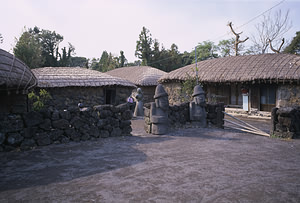Chonju
Midway along the Honam Expressway is Chonju, Korea's seventh largest city. Here you can find shops specializing in Korea's traditional mulberry paper, Hanji; is used in Caligraphy and making umbrellas, fans and other items. Chonju is famous for its gourmet dishes including Pibimpap (a large bowl of rice mixed with combination of vegetables and minced meat). People say: "Don't leave Chonju without tasting them".The lovely Kumsansa temple is about 20 miles southwest of Chonju. South of temple are Mt. Naejangsan National Park and Paegyangsa temple, which dates back to the 7th century. The national park is especially scenic in autumn with its grand display of crimson color fall foliages.
The name Naejang means 'many secrets' in the mountain. Because of the bright crimson leaves that blanket Naejangsan Mountain's fall scenery, the mountain is also referred to as "Geumgangsan of Honam."
Kwangju
The fifth largest city in Korea. As the capital city of Chollanam-do Province, it has been the administrative, economic and educational center of the province for centuries.Mt. Mudungsan, southeast of downtown Kwangju hovers over the city like guardian. It is famous for its watermelon (Mudungsan-Suhak) and Ch'unsol Tea or Spring Snow Tea is made out of soft buds which emerges from snow in early spring.
Unjusa Temple is situated 30 km to southwest of Hwasun-uptown. It was constructed by the great Buddhist Monk Tosonkuksa during the unified Shilla period (676-935). 18 pagodas and 80 Buddhas in and around the temple are all that remain of the 1,000 Buddhas and 1,000 pagodas that once belonged to this temple.
According to traditional theory of geomancy, Korea peninsula was thought of as a ship which was unbalanced because there were fewer mountains in Honam area, southwestern part of peninsula, than in the Yongnam area, southeastern part of peninsula, and was therefore in great danger of sinking. To prevent this disaster, thousands of Buddha statues and thousands Pagoda were believed to have been erected at temples in the southwestern part peninsula.
Tamyang, 22km north of Kwangju, is the center of Bamboo growing in Korea. It is also center of Bamboo craft, producing large quantities of bamboo furniture, house-hold items, and artwork. Bamboo markets open every five day in Tamyang. Tamyang Bamboo-ware Museum is houses more than 1,200 antique and modern bamboo's work from Tamyang as well as from foreign countries.
Chindo Island
A rare natural phenomenon takes place on Chindo Island, an island south of Mokp'o. It is possible to walk from Chindo island to a small neighboring island in the spring when an extremely low tide creates a land bridge twice a year. This occasion is known to many Korea's "Moses Miracle".





























